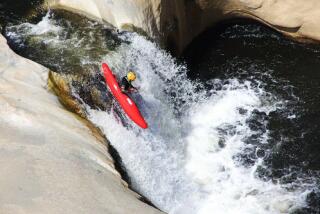All of Los Angeles--as least as much...
- Share via
All of Los Angeles--as least as much of it as had television then--watched on small, primitive screens 45 years ago as efforts to save a little girl’s life played out in stark black and white. Although it ended sadly, the event was credited with originating live TV news.
The 27 1/2-hour telecast on KTLA Channel 5 proved television’s power to convey immediate emotions as it focused on the attempt to rescue 3-year-old Kathy Fiscus of San Marino, who had fallen into an abandoned well constructed of a pipe only 14 inches in diameter and more than 100 feet deep.
On April 9, 1949, news had been on the air for only two years in Los Angeles, most of it scripted and rehearsed.
That Friday evening, Kathy had been running and playing in the tall, spring grass in an open field. Then, in an instant, she disappeared. Only her faint cries could be heard.
Kathy’s mother, Alice, called for help and emergency crews soon converged on the field.
*
For two days and nights, the effort to save her transfixed the city. Crowds gathered outside music and appliance store windows to watch on TV; others shared their sets with neighbors. There were about 20,000 television sets in Los Angeles County, which had a population of 4 million.
As rescue efforts continued into Saturday, KTLA’s general manager, Klaus Landsberg, decided to send sportscaster Bill Welsh and special events announcer Stan Chambers to the scene. KTLA’s other programs and commercials were canceled. As TV crews arrived, firemen had already slipped air hoses down the 45-year-old shaft. Crowds of spectators, who had heard of the rescue on radio or seen it on TV, had to be held back by police.
Volunteers answered calls for skilled help or people who might be able to maneuver in the cramped shaft. Among them was a former coal miner, who, until that moment, had sworn he would never go underground again; a former Navy diver; jockeys; and an unemployed construction foreman who borrowed carfare to get to the scene.
Alice Fiscus refused to give up hope. Early on, Kathy had managed to hold onto a rope. She was pulled up a few feet, but her tiny hands lost their grip and she slid back down.
The tension grew at every setback, but the digging went on. A shaft was excavated parallel to the pipe, but when workers tried to descend, the sides crumbled. Another shaft on the other side soon began to fill with water. Hourly reports let the public know how close rescuers were. Kathy had slid 94 feet down the shaft.
A microphone dangled into the pipe picked up what rescuers thought was Kathy’s breathing. The digging resumed with renewed fervor.
For 50 hours, volunteers and San Marino city workers raced the clock as television cameras rolled. When they finally cut through the corroded pipe at 6:03 p.m. Sunday, Kathy Fiscus was dead.
The family physician announced that she had probably died within two hours of slipping into the well. The coroner’s report would later say that Kathy died from lack of oxygen because her knees were pressed against her chest.
*
The dirty and tired rescue workers, along with a crowd of a thousand or more, wept openly. So did thousands more listening to the radio or watching the new medium of television.
Offers of jobs and more than $43,000 poured in for the 132 volunteers. Many of them pooled their shares for a Kathy Fiscus scholarship at Pomona College.
One month later, Gov. Earl Warren signed a bill to tighten safety requirements for abandoned wells. On the same day his daughter slipped down the water shaft, Kathy Fiscus’ father, David, a water engineer, had testified in Sacramento in support of covering abandoned wells with concrete.
David Fiscus died in 1975, and Alice now lives near another daughter, Barbara, in San Diego County. Kathy is buried in Chula Vista. Flowers are often left on her grave by strangers. Today, Alice Fiscus says: “It always astounds me when I think of all the wonderful things everyone did, giving of their time and hearts. I always hope in telling this story again, it might help other children.”
KTLA’s coverage was a turning point in TV history. Its marathon live reporting from the scene taught executives and audiences the potential of the news camera.
The old well that claimed the life of Kathy Fiscus has long since been filled in. There is no trace of it on what is now an athletic field at San Marino High School. The nearest reference is a bronze marker behind the San Marino City Library. The marker, like the one on Kathy’s grave, recalls “a little girl who brought the world together--for a moment.”
More to Read
Sign up for Essential California
The most important California stories and recommendations in your inbox every morning.
You may occasionally receive promotional content from the Los Angeles Times.













